The crucibles of life on Earth
Based on our current understanding of the cosmos, the biosphere, which provides for the needs of life on our planet, is the feature that makes Earth unique in the Universe. The number of ecosystems, and the strength and biodiversity within those ecosystems, are two of the leading measures of the health and vitality of the Earth’s biosphere. Distributed over numerous and remote locations on Earth, the variety of ecosystems is striking and includes: rain forests, boreal forests, grasslands, wetlands, alpine, tundra, deserts, coastal regions, fresh water, and salt water systems. Each of these ecosystems supports the biodiversity that ensures the vibrancy of life on Earth – and their interactions form a sacred balance that has allowed life on Earth to form, evolve, and adapt to ever-changing environmental conditions.
.jpg) |
In 1971 an inter-governmental treaty established the Ramsar Convention on Wetlands, establishing a framework for the stewardship and preservation of wetlands. 138 national signatories are obliged to report on the state of listed wetlands they are responsible for.
The GlobWetland Project is producing satellite-derived and geo-referenced products including inventory maps and digital elevation models of wetlands to assist with Ramsar reporting requirements. |
.jpg)
Conservation International has identified 25 biodiversity ‘hotspots’ that contain 44% of all plant species and 35% of
all land vertebrate species – despite accounting for just 1.4% of the Earth’s land area
Ecosystems provide the resources needed to support life on Earth and have a great impact on our wellbeing: both physical and economic, individual and national. The richness and biodiversity of Earth’s ecosystems provide people with food and nutrition, pharmaceutical drugs and herbal remedies, renewable resources and protection from weather, and cyclically replenished resources like fresh air and fresh water. It is not difficult to draw connections between the health and robustness of Earth’s ecosystems, and the health and robustness of the natural species (including humans) they support – and by extension their strong links to our economic prosperity. The stark reality, however, as discussed in Part I of this document, is that all available indicators point to an ‘overwhelming human dependence on rapidly deteriorating ecosystems’ – the systems that support all life on Earth:
- human action has transformed almost half of the Earth’s land surface;
- coastal and marine habitats are being dramatically altered; 50% of mangroves have been removed and wetlands have shrunk by one-half;
- extinction rates are increasing sharply in marine and terrestrial ecosystems around the world;
- 1 in 6 humans depends on fish for protein needs, yet 75% of the world’s fisheries are over-fished or fished at their biological limit;
- 41 of every 100 people live in water-stressed river basins;
- some 350 million people are directly dependent on forests for their survival, with global forest cover declining by 46% since pre-agricultural times.
Better understanding and management of future changes in Earth’s ecosystems and biodiversity are necessary to ensure their essential benefits are enjoyed by future generations. More information on the various ecosystems and their extent, on their complex interactions, their response to local and global environmental changes, and on their capacity to sustain biodiversity is needed to develop this understanding and to provide the evidence needed to guide scientific study, inform public opinion, and support cooperative protection measures, e.g. through international conservation treaties.
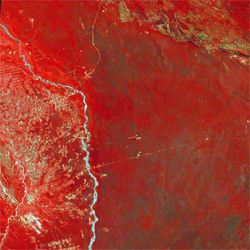 |
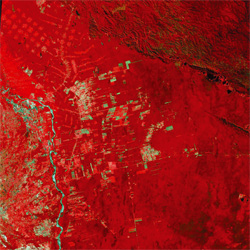 |
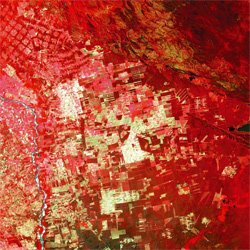 |
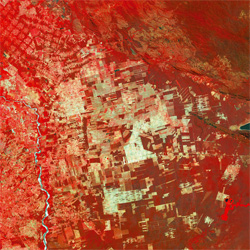 |
| Landsat time series (1975, 1992, 2000, 2002) images of large scale deforestation in the Amazon. Such images have raised global awareness of deforestation. |
The role for Earth observation satellites
The challenge of conserving our precious ecosystems and biodiversity is compounded by their distribution around the globe, the fact that they often span national boundaries, and by their remoteness. This is where remote sensing technologies such as Earth observation satellites can play a significant role.
Some scientists are using remote-sensing technology to better understand relationships between species and the places they live. Satellites’ ability to routinely observe even the most remote areas can make biologists’ search for important species and habitats quicker and easier – particularly in remote or hazardous areas where access may be hazardous or prohibitively expensive.
Current and planned Earth observing missions offer a broad range of monitoring capabilities of value to conservation efforts – from monitoring the rate of land use change each year for farmland or urban growth, to the frequency and severity of air pollution events, to increased ocean temperatures in sensitive coral habitats.
Improvements in spatial resolution are enabling more and more specific, local information to be derived – and in some rare cases, high resolution satellites can directly observe (particularly large) species on the ground. Mostly though, environmental data or images from satellites offer indirect but invaluable information about species and their habitat including environmental, biological, and physical information – topography, rainfall, forest cover – that reveal where species are likely to be found and the nature of possible extinction threats. Satellite imagery is proving to be an extremely compelling way to show politicians and land managers what is going on and how land has changed.
During the last few years, there has been rapid adoption and use of data from several Earth observation satellites – including Landsat, SPOT, ENVISAT, RADARSAT, Terra and others by NGOs (e.g. The Nature Conservancy, Global Forest Watch of the World Resources Institute, Conservation International). Their analyses are primarily related to conservation, especially in relation to biodiversity. The results of this work have led to several definitive analyses of land cover change in many parts of the world including Mozambique, the boreal forests of northern Eurasia, Indonesia, Cameroon, and several countries in South America.
These and other projects have exploited the ability of multi-spectral electro-optical and radar satellite sensors to detect land cover change, determine vegetation abundance, discriminate vegetation types, and detect and map invasive species. Such data is valuable in charting the main environmental factors which researchers believe drive patterns of biodiversity: vegetation growth, habitat structure, and climate. New capabilities of ‘hyper-spectral’ sensors (which provide more unique identification information on chemical composition of vegetation and land cover materials) and of ‘vegetation canopy lidars’ (which can map the 3-D vegetation structure in an ecosystem) will further add to the wealth of data from satellites used in conservation studies.
While these new technologies and techniques offer a far greater range of information than has ever been possible before, there are still challenges to using satellite data effectively. For starters, remote sensing data need to be validated, or compared with other sources of information to see if there is agreement. Such ‘ground-truth’ information might come from ground-based sensors, higher-resolution remote-sensing sources, like aerial photographs, or researchers in the field. Affordability and ease of access of the best satellite data available are further issues to be addressed if we are to make full use of their potential.
| Space technologies to support the World Heritage Convention |
.jpg)
Lulenga, an eleven-year-old mountain gorilla,
chews part of the roughly 30 pounds of
foliage he eats daily in Congo’s Virunga
National Park. Lulenga has led his group since his father was killed by poachers in 1995.
There are about 600 mountain gorillas left in
the world, most of whom thrive in this
relatively small volcanic forest habitat
preserved by the park, which overlaps
into the neighbouring countries Rwanda
and Uganda.
|
Surveillance of the Gorilla Habitat (SOGHA) is the first outcome of an agreement signed in 2001 between the European Space Agency (ESA) and the United Nations Educational, Scientific and Cultural Organisation (UNESCO) to use remote sensing and other space technologies to monitor World Heritage Sites.
UNESCO together with the involved countries has recognized the mountain gorilla habitat – and specifically the area included in the Virunga National Park in the Congo, bordering Rwanda and Uganda, and the Bwindi Impenetrable National Park in Uganda – to be World Heritage Sites. But these habitats are increasingly coming under pressure as regional conflicts cause an influx of refugees. Clearing forest land for agriculture or fuel, and poaching for food have reduced the living space left for the gorillas. That is why the WHC has classified the sites in the Congo as World Heritage sites in danger.
Wildlife workers on the ground are limited in their monitoring capacity because these habitats total more than eight hundred thousand hectares, with long boundaries across extremely inaccessible and seldom-mapped terrain. As a result, UNESCO and ESA agreed to begin a pilot scheme using satellite data to monitor the changes of land use in the gorilla habitats and to identify possible environmental indicators.
Radar instruments on board satellites such as ESA’s ERS-2 and Envisat can pierce through the near-total cloud cover of the rainforest to identify illegal forest clearance or settlements, data that can be integrated with visible imagery from satellites and with ground observations provided by organisations working in the area – before being supplied to local authorities. |
.jpg)
Satellite-derived elevation map
|
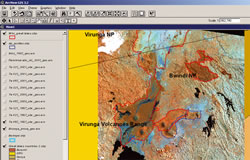
Multiple satellite and in-situ
data sources, combined with
local knowledge and gorilla
sightings are combined in the
project GIS |
.jpg) |
In this transfrontier region of
Uganda, Rwanda, and the
Democratic Republic of Congo, the
volcanic highlands of the Virungas
shelter the last 600 plus mountain
gorillas in the world. Photo:
Courtesy of International Gorilla
Conservation Program (IGCP) a
coalition of AWF, WWF and FFI. |
BACK TO TOP
|
